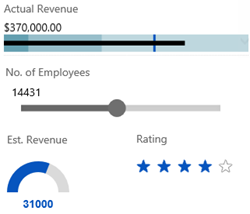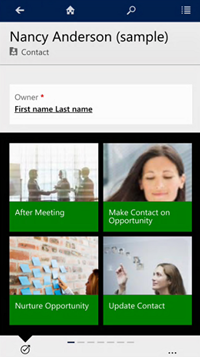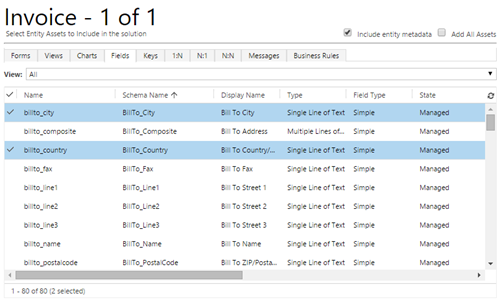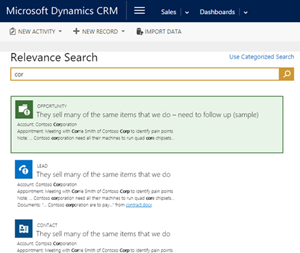Related sites:
Newsletter: Perspectives on Power Platform
Company: Niiranen Advisory Oy

Another year, another major Dynamics CRM release! What a time to be alive, eh? CRM 2016 has now been published for new Online trial instances globally and will be coming available as on-premises download within the next couple of weeks. If you haven’t yet explored what’s new with Dynamics CRM 2016 then I recommend starting from the following three links that I personally always refer to when discussing the latest version:
Rather than just making it a “go and RTFM” type of post, here are a few notable features in the latest release that I personally think you should pay attention to.
For folks upgrading their on-premises CRM environments, this is definitely a sizable release, as the features from CRM Online 2015 Update 1 (v7.1) are only now becoming available to them. Working mostly with CRM Online environments these days, it does really feel painful whenever I have to go back to the pre-7.1 Nav Bar, so the new navigation experience should definitely cheer up your users who are now spared from the game of sideways scrolling accuracy Olympics. I’ve yet to find a single thing that the new navigation would be worse for than the old one released in CRM 2013. Don’t forget to configure a custom theme & logo for your CRM while visiting the customizations menu! Oh, and remember to leverage this Theme Generator, since MS apparently had to cut the development budget when it came to “nice to have” things like color pickers instead of hex codes.
Moving from 7.1 to 8.0 may not deliver any immediately visible changes to you, as Microsoft has largely decided not to introduce anything dramatic in the look & feel of the familiar web client. One thing you may notice, though, is a yellow notification bar telling you something about an “interactive service hub” and asking you to “experience it now”. Hmm, sounds interesting, so maybe I’ll click on it and… Whoa, what’s happening?! Why am I seeing the same customization download screen as on the tablet client? And where did half of my menu items from the Nav Bar go all of a sudden?
So you thought there’s not much new in the CRM 2016 UI, huh? There definitely is a lot of new investments to be found here, ranging from brand new “interactive experience dashboards” to updated form layouts with embedded cards, revised components like Timeline (ex Social Pane) and new concepts like the Reference Panel (“Related”). It’s all built on top of the MoCA framework, and it gives you a taste of how the Dynamics CRM application of the future will behave: less like a web page and more like an app.
Why do I say “the future” if it’s in fact already available in CRM 2016, for both Online and on-prem customers? Well, if you’re an existing Dynamics CRM user, the chances are that you’re not going to deploy this into production use quite yet. For starters, it only supports a limited set of the core CRM entities like account, contact, activity and case. Sales opportunities, leads, marketing lists or campaigns aren’t within the scope of this release. While you can show custom entities in the Interactive Service Hub, you’ll not be able to perform many of the more advanced customization tasks that the traditional Dynamics CRM web client supports, like embedding web resources or Iframes to forms.
There’s a lot to like about the new user experience that this “interactive” web client presents us with. The new dashboards especially appear to address many of the requests that CRM users typically have, like the ability to apply global filters to all the charts. The method of presenting related records and streams of activities is definitely more in line with the way modern mobile apps work, even if the experience itself feels a bit too mobile for a full size monitor in terms of information density. Still, in its current state it remains more of an experimental release that’s not meant for wider adoption yet. Much like the infamous Polaris release prior to CRM 2013, this Interactive Service Hub will be best used for learning about and preparing for the direction of future Dynamics CRM web clients.
Explaining this grand scheme of things to the customers will be tricky, as it was with Polaris. For example, in order to leverage the new Knowledge Articles you have to access them via The Hub, presumably because Microsoft hasn’t wanted to build a rich text editor UI for the old web client anymore but has rather focused their investments on MoCA. Within the right feature scope you can probably do cool stuff with this client already, it’s going to required setting the right expectation level right from the start. Oh well, I guess that’s what us consultants are there for…
 On the mobile apps there is now the ability include new types of visual controls for the mobile forms that can make CRM data both a lot more pleasing to the eye as well as easier to work with on a touch screen device. While many of these new controls would surely be great additions to have on normal web client forms as well, Microsoft has decided not to enable them for browser users of CRM in this release. Remember what I said about the MoCA framework being the focus area for MS?
On the mobile apps there is now the ability include new types of visual controls for the mobile forms that can make CRM data both a lot more pleasing to the eye as well as easier to work with on a touch screen device. While many of these new controls would surely be great additions to have on normal web client forms as well, Microsoft has decided not to enable them for browser users of CRM in this release. Remember what I said about the MoCA framework being the focus area for MS?
 Task Based Experiences (“TBX”) a.k.a. Task Flows is another new feature that is not just “mobile first” but “mobile only”. The idea behind these experiences is to be independent from the underlying entity relationship model and rather guide the user through a set of screens that present a subset of only the relevant fields from each related record that need to be touched in the process. What’s a bit cumbersome in this release is that TBX isn’t actually launched for a specific record but rather from the bottom left corner of the mobile app start screen. It’s almost like the old (and mostly abandoned) Dialogs feature from CRM 2011 but with a more modern approach, including the ability to add nice looking photo icons for the launch menu.
Task Based Experiences (“TBX”) a.k.a. Task Flows is another new feature that is not just “mobile first” but “mobile only”. The idea behind these experiences is to be independent from the underlying entity relationship model and rather guide the user through a set of screens that present a subset of only the relevant fields from each related record that need to be touched in the process. What’s a bit cumbersome in this release is that TBX isn’t actually launched for a specific record but rather from the bottom left corner of the mobile app start screen. It’s almost like the old (and mostly abandoned) Dialogs feature from CRM 2011 but with a more modern approach, including the ability to add nice looking photo icons for the launch menu.
The designer for TBX actually is the same as for another fairly recent three letter acronym, meaning BPF (“Business Process Flows” for the not so regular readers of CRM blogs). At first this seems like a bit of an odd choice, but once you realize that actually BPFs also attempt to blend the various entities that a process spans across into a more logical user interface, the logic becomes more obvious. TBX is a Preview feature in CRM 2016 and has a number of limitations still, but the concept is quite fascinating because this, in essence, is what mobile CRM is about. Not cramming your old data models and app features into smaller touch screens but redesigning how users interact with CRM without “using it” in the traditional sense of sitting down and browsing a big database of records. Contextual information with just the right options presented to the user – it’ll take a lot of work from the platform development as well as solution design perspective, but that’s where we’ll need to get to.
 The app mania doesn’t spare event the desktop users in this release, since the CRM App for Outlook is coming out of Preview in this release and also finally available for CRM Online & Exchange Online users outside of North America. Not to be confused with the heavy CRM Outlook client with a whole bunch of legacy weight on its shoulders, this is a modern lightweight browser app that’s accessible without any installation footprint in both Outlook for the web (formerly known as OWA), Outlook 2013/2016/Mac desktop app and also on the mobile. Do note however that “mobile” doesn’t mean the Outlook App that everyone’s using on their iPhone & Android (the Acompli app bought & rebranded by MS) but rather the Mobile OWA browser version. You can only track incoming emails to CRM in this release, but the app already does show quite a nice view of the related CRM records + the ability to create new records. The UI is once again MoCA all the way, which shouldn’t surprise anyone at this point. While it may not yet be fully ready to replace the Outlook client, the App gives a taste of a future in which fighting disabled Outlook add-ins will no longer be the price you have to pay for linking activities into your CRM database.
The app mania doesn’t spare event the desktop users in this release, since the CRM App for Outlook is coming out of Preview in this release and also finally available for CRM Online & Exchange Online users outside of North America. Not to be confused with the heavy CRM Outlook client with a whole bunch of legacy weight on its shoulders, this is a modern lightweight browser app that’s accessible without any installation footprint in both Outlook for the web (formerly known as OWA), Outlook 2013/2016/Mac desktop app and also on the mobile. Do note however that “mobile” doesn’t mean the Outlook App that everyone’s using on their iPhone & Android (the Acompli app bought & rebranded by MS) but rather the Mobile OWA browser version. You can only track incoming emails to CRM in this release, but the app already does show quite a nice view of the related CRM records + the ability to create new records. The UI is once again MoCA all the way, which shouldn’t surprise anyone at this point. While it may not yet be fully ready to replace the Outlook client, the App gives a taste of a future in which fighting disabled Outlook add-ins will no longer be the price you have to pay for linking activities into your CRM database.
System customizers and developers get their fair share of new features with the CRM 2016 release. There’s been some very significant enhancements made to the solution framework. The first item is the ability to select individual subcomponents of an entity to be added into the solution, instead of the whole entity and all that’s related to it. What this means is that your solution might contains just a single attribute to be added for the entity, which will naturally reduce the dead weight in the solution file and most importantly allow you to NOT overwrite all of the other customizations for the entity when working with unmanaged solutions. Just pick the entity assets that you really want to modify and leave out all the rest.

For those who are developing ISV products or otherwise have an automated release process in place that can support working with managed solutions, there’s now the ability to ship patches that contain just the subcomponents requiring updates. Then once it’s time to release an actual new major or minor version of the solution, you can roll up the changes from patches and ship the new package with all the components. This new level of granular control in solution contents is surely going to make it much more convenient to only change the configurations you intended to and avoid conflicts with overlapping solutions targeting the same entities.
For all you developers out there, it’s time to embrace the brand new Web API, that was earlier available as a Preview in v7.1. With full support from Microsoft now being offered, it’s likely that this modern platform & language independent API will quickly become the new norm for how you integrate your applications with Dynamics CRM. For plug-in development you’ll still need to write your code the old fashioned way by referencing the SDK assemblies, though.
In this day of cloud based reporting solutions like Power BI, the API side of CRM has actually become more relevant to also non-developers like myself. That’s because OData is the method via which the CRM data will be retrieved into reports. Now, since the new Web API essentially is OData, there’s going to be a new data source to be leveraged for your Power BI dashboards. While the old OData V2 endpoint is being deprecated in CRM 2016, the new OData V4 API promises both a significant improvement in performance as well as more easily accessible data for things like optionset labels. Definitely something to be explored in a future blog post in more detail.
A big new feature that Microsoft has made a part of the core Dynamics CRM platform via an acquisition made earlier this year is surveys. Unfortunately the “Voice of the customer” feature hasn’t made it to CRM 2016 GA yet, but it will rather be launched later. Given that this product had been designed as an XRM solution from day one (launched as Mojo Surveys), it’s a bit strange that it takes so long for MS to make it an official offering, but we can only speculate that perhaps there’s further enhancements being made to the survey functionality before rolling it out to the customers. From the updated CRM Online Pricing & Licensing Guide (December 2015) we can already see that publishing the surveys will require a CRM Enterprise user license, so be prepared to upgrade the users who’ll be leveraging this feature in your organization.
 Another major deliverable that isn’t quite ready for prime time yet is the new search feature, a.k.a. Relevance Search. Even though the Multi-entity Quick Find in CRM 2015 was an important enhancement for Dynamics CRM usability, the somewhat awkward search experience of wildcard based, single term search still isn’t quite what the average Google user would expect. That’s about to change with the next generation search that will introduce proper content indexing with multiple search words and result relevance ranking. It’ll be awesome, but we’ll have to wait until spring 2016 to see it appear in the CRM Online orgs.
Another major deliverable that isn’t quite ready for prime time yet is the new search feature, a.k.a. Relevance Search. Even though the Multi-entity Quick Find in CRM 2015 was an important enhancement for Dynamics CRM usability, the somewhat awkward search experience of wildcard based, single term search still isn’t quite what the average Google user would expect. That’s about to change with the next generation search that will introduce proper content indexing with multiple search words and result relevance ranking. It’ll be awesome, but we’ll have to wait until spring 2016 to see it appear in the CRM Online orgs.
One more item that’s been high up on the want list for Dynamics CRM customers is the offline support for mobile apps. As of today, that’s still missing in action and not appearing in any of the official “what’s new” links for CRM 2016, but Jujhar’s post does highlight it, so presumably it’ll be rolling out in the near future. What we already know for sure is that only CRM Online customers will be able to leverage the offline capability in the Dynamics CRM clients (at least for now), but other information about the service coverage still remains to be confirmed. With mobile CRM app developers like Resco having invested heavily into both offline data availability and offline access for the any custom code extensions in the app, it will be interesting to see how Microsoft’s own offering can match the expectations set by these third party apps. For the time being, FieldOne (acquired by Microsoft) will continue to operate on top of Resco’s mobile app to provide offline functionality for field service personnel.
Aside from just the deliverables of the Dynamics CRM product team, there’s exciting things happening with other Microsoft products that can potentially have a big impact on the role that CRM will play in the business application stack of organizations. This week at Convergence 2015 EMEA the announcement of Microsoft PowerApps was made, with a promise of business users being able to design mobile apps that connect with CRM Online. On the machine learning / BI front, Cortana Analytics is being advertised as the “big data and advanced analytics suite that enables you to transform your data into intelligent action”. With these type of announcements in mind, it’s easy to see how the Dynamics CRM roadmap presented at Convergence connects with these broader trends in software that Microsoft is investing in.
For a summary of the Dynamics CRM related news shared at Convergence 2015 EMEA, check out my Storify collection of tweets from the #Conv15 hashtag.